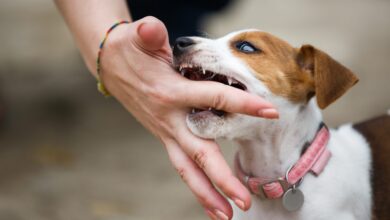How To Train A Dog To Shake Hands

How to train a dog to shake hands – Training your dog to perform tricks not only strengthens the bond between you and your furry friend but also provides mental stimulation and enhances their overall obedience. One popular and adorable trick is teaching your dog to shake hands. This article will provide a comprehensive guide on how to train your dog to shake hands, along with frequently asked questions and their answers. EnoughInfo.com
Shaking hands is a fun trick that can be taught to most dogs. It’s a great way to show off your dog’s intelligence and obedience, and it’s also a great way to get them excited about training.
Training your dog to shake hands is important for fostering a strong bond, providing mental stimulation, enhancing obedience, promoting positive behavior, and creating a well-rounded and well-behaved canine companion. It is a rewarding experience that benefits both you and your furry friend in multiple ways. How To Make Homemade Body Scrub
Read Also: How to Train a Puppy to Sit (Step-by-Step Guide)
Here are some common mistakes to avoid when training your dog to shake hands:
- Not being patient enough. Training a dog takes time and patience. Don’t get discouraged if your dog doesn’t get it right away. Just keep practicing and they will eventually get it.
- Not using high-value treats. You want your dog to be motivated to learn the trick, so use treats that they really love.
- Not being consistent with the command word. Use the same command word every time you want your dog to shake hands. This will help them associate the command word with the action.
- Getting frustrated. If you get frustrated, your dog will get frustrated too. Just take a break and come back to it later.
With a little patience and consistency, you can teach your dog to shake hands in no time!
Why Teach Your Dog to Shake Hands?
Teaching your dog to shake hands serves both practical and entertainment purposes. It enhances your dog’s obedience skills and strengthens its ability to follow commands. Additionally, it provides mental stimulation, improves their focus, and boosts their confidence. Moreover, a well-trained dog that can shake hands impresses friends, family, and strangers, creating a positive social experience for both you and your canine companion. How To Do A Basic Skincare Routine
Preparing for Training:
Before diving into the training process, it’s important to gather a few essential items:
a. Treats: Prepare small, soft, and bite-sized treats that your dog loves. These treats will serve as positive reinforcement during the training sessions.
b. Clicker (Optional): A clicker can be used as a secondary reinforcement tool to mark the desired behavior. It’s not necessary, but some dogs respond well to this training method.
c. Quiet Training Area: Find a quiet space free from distractions where you and your dog can focus on training without interruptions. https://enoughinfo.com/how-to-train-a-dog-to-shake-hands
Read Also: How To Calm A Sexually Excited Dog
Step-by-Step Guide To Training Your Dog To Shake Hands:
Basic Commands
Before teaching the handshake, ensure your dog is familiar with basic commands such as “sit” and “stay.” These commands create a foundation of obedience and make subsequent training easier.
Introduction to Touch
Start by teaching your dog to touch its nose to the palm of your hand. Hold your hand out in front of them, close to their nose, and say “Touch.” When their nose makes contact with your hand, immediately reward them with a treat and praise. Repeat this process until your dog consistently touches your hand on command.
Introducing the Handshake Gesture
Once your dog is comfortable with touching their nose to your hand, you can introduce the handshake gesture. Extend your hand towards your dog’s paw and say “shake” or any other cue word you prefer. If your dog lifts their paw even slightly, reward them with a treat and praise. Repeat this step, gradually requiring a more pronounced paw lift before giving the reward.
Associating the Cue Word
At this stage, you will associate the cue word, such as “shake,” with the action of your dog lifting its paw. Just before extending your hand, say the cue word clearly and then proceed with the handshake gesture. As soon as your dog lifts their paw, reward them with a treat and praise. Repeat this step multiple times, reinforcing the association between the cue word and the action.
Adding Verbal Commands and Removing Hand Gestures
In this final step, you will gradually fade out the hand gesture and rely solely on the verbal command. Start by giving the cue word without extending your hand. If your dog lifts their paw, reward them with a treat and praise. If they don’t respond, you can reintroduce the hand gesture temporarily to remind them of the desired action. Over time, phase out the hand gesture completely and rely solely on the verbal command. Consistently reward your dog each time they successfully shake hands. https://enoughinfo.com/how-to-train-a-dog-to-shake-hands
Read Also: How To Practice Self Care(All You Need to Know)
Troubleshooting Common Challenges:
Training a dog to shake hands may come with a few challenges. Here are some common issues and ways to address them:
a. Lack of Interest: If your dog seems disinterested or unresponsive during training sessions, ensure they are in a calm and focused state before starting. Use high-value treats, engage in short training sessions, and make it a fun and positive experience.
b. Pawing at Inappropriate Times: If your dog starts pawing at people indiscriminately, it’s essential to differentiate between the handshake cue and other situations. Reinforce the handshake command only in the training context and discourage pawing in other situations through redirection and training appropriate boundaries.
c. Inconsistent Response: If your dog is inconsistent in lifting their paw during training, go back to the previous step and reinforce the behavior with rewards. Ensure your timing is precise when delivering treats, and be patient as some dogs may take longer to grasp the concept.
Read Also: How To Make A DIY Face Mask For Oily Skin
Frequently Asked Questions (FAQs) and Answers:
1, How long does it take to train a dog to shake hands?
The training duration can vary depending on the individual dog and the consistency of training. With regular practice and positive reinforcement, most dogs can learn to shake hands within a few weeks.
2, Can any dog learn to shake hands?
Yes, most dogs can learn to shake hands. However, some breeds may be more inclined towards certain behaviors, and individual temperament and willingness to learn can also influence the training process. How To Play The Saxophone For Beginners
3, What are the recommended treats for training?
Small, soft, and easily chewable treats are ideal for training. You can use commercially available training treats or cut up-small pieces of soft treats like boiled chicken, cheese, or freeze-dried liver.
4, Should I use clicker training for teaching the handshake?
Clicker training can be effective for teaching the handshake. The clicker serves as a marker to indicate the correct behavior, and you can follow it with a treat. However, it’s not necessary, and verbal praise can also be used as reinforcement.
5, How do I prevent my dog from pawing at people indiscriminately?
To prevent indiscriminate pawing, teach your dog a clear distinction between the handshake command and other situations. Reinforce the handshake cue only during training sessions and discourage pawing in other contexts. Redirect their attention to appropriate behaviors and reinforce good manners. How To Create A DIY Home Renovation Plan
Read Also: How to Build a Sustainable and Healthy Diet Plan (2023)
Conclusion:
Training your dog to shake hands is a delightful and rewarding experience for both you and your furry friend. With patience, consistency, and positive reinforcement, you can successfully teach your dog this charming trick. Remember to create a calm and focused training environment, use treats and praise to reward desired behavior, and gradually fade out the hand gesture while relying on the verbal command. Troubleshoot any challenges that arise, such as a lack of interest or inconsistent response, and address them with patience and persistence.
Training your dog to shake hands is not only a fun trick but also a wonderful way to strengthen your bond and enhance their obedience skills. Enjoy the training journey with your canine companion, and celebrate each milestone achieved. Happy training!


